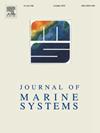Modeling how eutrophication in northern Baltic coastal zone is driven by new nutrient inputs, internal loading, and 3D hydrodynamics
IF 2.5
3区 地球科学
Q2 GEOSCIENCES, MULTIDISCIPLINARY
引用次数: 0
Abstract
The nutrient load and the resulting eutrophication responses in the Archipelago Sea, a northern Baltic Sea basin, were assessed by developing the FICOS model system (Finnish Coastal Nutrient Load Model). FICOS includes a simple but sufficiently mechanistic biogeochemical (BGC) model with two functional phytoplankton groups (strict autotrophs and diazotrophic N2 fixing cyanobacteria) accounting for key processes in the Baltic nitrogen‑phosphorus cycle. The BGC model is linked to a high-resolution 3D hydrodynamic coastal model and includes all important nutrient sources. We applied Bayesian inference on time series of dissolved inorganic phosphorus (DIP), dissolved inorganic nitrogen (DIN), chlorophyll a (Chla), and algal biomass observations to estimate five unknown phytoplankton growth parameters of the BGC model, and the uncertainties associated with them, as well as to calibrate the model predictions. In general, the calibrated BGC model simulated well the time courses of the observations at three intensive monitoring stations in the Archipelago Sea.
Main sources of new nutrients to the Archipelago Sea include catchment area, atmosphere, point load (e.g. fish farming), N2 fixation by cyanobacteria and background transport from open sea. An important and characteristic additional nutrient source in the shallow area is recycling from bottom sediments. During the season of phytoplankton growth, this internal load was the most important DIP source for the productive surface layer. In the sheltered basin coupled with the main river Aurajoki (area 1221 km2), about half of the DIP released from sediments was transported to the surface. For DIN in the Aurajoki basin, atmospheric deposition and catchment load were the most important sources for phytoplankton, both accounting for about 30 % of total surface inputs. In the whole Archipelago Sea, annual inputs of DIP and total P were dominated by internal load while atmospheric load was the most important DIN source. Import from the northern Baltic proper was the other main source of both forms of N and P.
During the growth season in the Aurajoki basin, high internal DIP load led to low surface DIN:DIP input ratio, indicating primary N-limitation of phytoplankton. The internal DIP load and catchment area DIN load were the local inputs with the widest impact areas in model simulations, suggesting that local inorganic nutrient loads were exhausted within the coastal zone during the growth season. Furthermore, Bayesian uncertainty analysis of nutrient load scenario predictions suggested that good environmental status (below 2.5–3.0 μg Chla L−1) is achievable in the Aurajoki basin only with drastic reductions in practically all anthropogenic loads.
模拟波罗的海北部沿海地区的富营养化是如何由新的营养输入、内部负荷和三维流体动力学驱动的
通过开发FICOS模型系统(芬兰沿海养分负荷模型),对波罗的海北部盆地群岛海的养分负荷及其富营养化反应进行了评估。FICOS包括一个简单但足够机械的生物地球化学(BGC)模型,其中两个功能浮游植物群(严格自养和重氮营养化固氮蓝藻)解释了波罗的海氮磷循环的关键过程。BGC模型与高分辨率的3D水动力海岸模型相关联,包括所有重要的营养来源。利用贝叶斯推理方法对溶解无机磷(DIP)、溶解无机氮(DIN)、叶绿素a (Chla)和藻类生物量的时间序列观测数据进行分析,估计了BGC模型中未知的5个浮游植物生长参数及其不确定性,并对模型预测结果进行了校正。总体而言,校正后的BGC模式较好地模拟了群岛海三个密集监测站的观测时间过程。群岛海新营养物的主要来源包括集水区、大气、点负荷(如养鱼)、蓝藻对氮的固定和来自远海的本底运输。浅水区一个重要的、有特色的附加营养源是海底沉积物的再循环。在浮游植物生长季节,这种内负荷是生产表层最重要的DIP源。在与主要河流Aurajoki相连的遮蔽盆地(面积1221 km2),沉积物释放的DIP约有一半被输送到地表。对于Aurajoki流域的DIN,大气沉降和流域负荷是浮游植物最重要的来源,均占地表总输入量的30%左右。在整个列岛海,DIP和总P的年输入以内部负荷为主,大气负荷是最主要的DIN来源。来自北波罗的海固有海域的进口是氮和磷的另一个主要来源。在Aurajoki盆地生长季节,高内部DIP负荷导致表面DIN:DIP输入比低,表明浮游植物对氮的初级限制。在模型模拟中,内部DIP负荷和集水区DIN负荷是影响区域最广的局部输入,表明在生长季节,局地无机养分负荷在海岸带内被耗尽。此外,养分负荷情景预测的贝叶斯不确定性分析表明,只有在几乎所有人为负荷都大幅减少的情况下,Aurajoki盆地才能达到良好的环境状态(低于2.5-3.0 μg Chla L−1)。
本文章由计算机程序翻译,如有差异,请以英文原文为准。
求助全文
约1分钟内获得全文
求助全文
来源期刊

Journal of Marine Systems
地学-地球科学综合
CiteScore
6.20
自引率
3.60%
发文量
81
审稿时长
6 months
期刊介绍:
The Journal of Marine Systems provides a medium for interdisciplinary exchange between physical, chemical and biological oceanographers and marine geologists. The journal welcomes original research papers and review articles. Preference will be given to interdisciplinary approaches to marine systems.
 求助内容:
求助内容: 应助结果提醒方式:
应助结果提醒方式:


